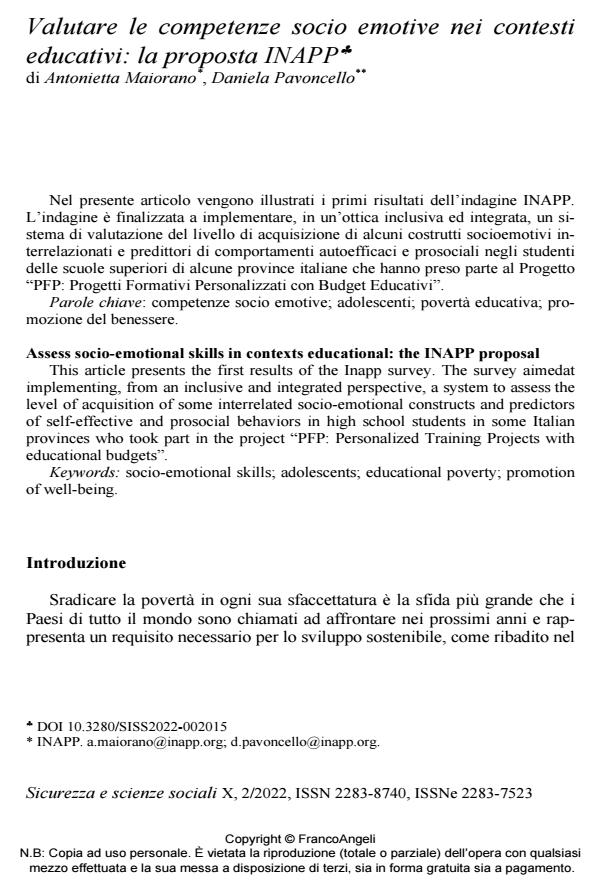Assess socio-emotional skills in contexts educational: the INAPP proposal
Journal title SICUREZZA E SCIENZE SOCIALI
Author/s Antonietta Maiorano, Daniela Pavoncello
Publishing Year 2022 Issue 2022/2 Language Italian
Pages 20 P. 224-243 File size 316 KB
DOI 10.3280/SISS2022-002015
DOI is like a bar code for intellectual property: to have more infomation
click here
Below, you can see the article first page
If you want to buy this article in PDF format, you can do it, following the instructions to buy download credits

FrancoAngeli is member of Publishers International Linking Association, Inc (PILA), a not-for-profit association which run the CrossRef service enabling links to and from online scholarly content.
This article presents the first results of the Inapp survey. The survey aimedat implementing, from an inclusive and integrated perspective, a system to assess the level of acquisition of some interrelated socio-emotional constructs and predictors of self-effective and prosocial behaviors in high school students in some Italian provinces who took part in the project "PFP: Personalized Training Projects with educational budgets£.
Keywords: socio-emotional skills; adolescents; educational poverty; promotion of well-being.
- Baiocco R., Cacioppo M., Laghi F., Tafà M. (2013). Factorial and Construct Validity of FACES IV among Italian adolescents. Journal of Child and Family Studies, 22, 2013.
- Chiosso G. (2022). Competenze non cognitive per contrastare la dispersione scolastica, -- testo disponibile al sito in https://www.avvenire.it/attualita/pagine/competenze-non-cognitive-per-contrastare-la-dispersione-scolastica, 25 febbraio 2022.
- Coopersmith S. (1967). The antecedents of self-esteem. San Francisco: W. H. Freeman and Company.
- Curbow B. & Somerfi eld M. (1991). Use of the Rosenberg Self-esteem Scale with adult cancer patients. Journal of PsychosocialOncology, 9, 113-131.
- Davis M.H. (1980). A Multidimensional Approach to Individual Differences in Empathy. JSAS Catalog of Selected Documents in Psychology, 10.
- Davis M.H. (1996). Empathy: A social-psychological approach. Boulder, CO: Westview.
- Davis M. H. (1983). Measuring individual differences in empathy: Evidence for a multidimensional approach. Journal of Personality and Social Psychology, 44(1), 113–126.
- DeNeve, K. M., & Cooper, H. (1998). The happy personality: A meta-analysis of 137 personality traits and subjective well-being. Psychological Bulletin, 124(2), 197-229.
- Goleman D. (1995). Emotional Intelligence. Bantam Dell Pub Group (trad. it: Intelligenza Emotiva, Rizzoli, 1996) Gross JJ. (2002) Emotion regulation: affective, cognitive, and social consequences. Psychophysiology, 39(3): 281-91.
- Hooley T., Sultana R. e Thomsen R. (2020). Why a social justice informed approach to career guidance matters in the time of coronavirus. -- https://careerguidancesocialjustice.wordpress.com/2020/03/23/why-a-social-justice-informed-approach-to-career-guidance-matters-in-the-time-of-coronavirus/
- Kaplan H. B., Pokorny A. D. (1969). Self-derogation and psychosocial adjustment. Journal of Nervous and Mental Disease, 149(5), 421-434.
- Kernis Mh., Granneman B.D. y Mathis L.C. (1991). Stability of self-esteem as a moderator of the relation between level of self-esteem and depression. Journal of Personality and Social Psychology, 61(1), 80-84.
- Marmocchi P., Dall’aglio C., Zannini M. (2004). Educare le life skills. Come promuovere le abilità psico-sociali e affettive secondo l’Organizzazione Mondiale della Sanità. Trento: Erickson.
- Mastropasqua I., Pagliaroli T., Totaro M.S. (2008). Primo Rapporto sulla devianza minorile in Italia, I Numeri pensati, Dipartimento per la Giustizia Minorile. Centro europeo di Studi di Nisida: Gangemi editori.
- Osservatorio Povertà educativa. (2022) Le mappe della povertà educativa in Italia, #conibambini, Openopolis, -- https://www.openpolis.it, gennaio.
- Pavoncello D. et alii. (2013). Giovani tra speranza, fiducia e progettualità: Risultati di una ricerca. Orientamenti Pedagogici, vol. 60, n. 3/2013: 591-610.
- Pavoncello D. et alii. (2014). Prevenire si può. Misure di accompagnamento per la transizione scuola lavoro dei giovani con disabilità psichica. I libri del FSE, Revelox: Roma.
- Payton J., Weissberg R.P., Durlak J.A., Dymnicki A.B., Taylor R.D., Schellinger K.B., & Pachan M. (2008). The positive impact of social and emotional learning for kindergarten to eighth-grade students: Findings from three scientific reviews. Chicago, IL: Collaborative for Academic, Social, and Emotional Learning.
- Raciti P., Vivaldi Vera P. (2020). Escala de RegulaciónEmocional RE-MESACTS. Resultados del proceso de validaciónpsicométrica en seispaíses de América Latina. Medellín: MESACTS -- https://www.mesacts.com/wp-content/uploads/2020/03/Escala-de-Regulación-Emocional-RE-MESACTS_publicación-oficial-febrero-2020.pdf
- Roberts J.E., Monroe S.M. (1992). Vulnerable self-esteem and depressive symptoms: Prospective findings comparing three conceptualizations. Journal of Personality and Social Psychology, 62(5), 804-812.
- Robins R.W., Hendin H.M. & Trzesniewski K.H. (2001). Measuring global self-esteem: Construct validation of a single item measure and the Rosenberg Self-Esteem Scale. Personality and Social Psychology Bulletin 27, 151-161.
- Rosenberg M. (1965). Society and the adolescentSelf-image. Princeton: Princeton University Press.
- Ryan R. M., Deci E. L. (2001). On happiness and human potentials: A Review of Research on Hedonic and Eudaimonic Well-Being. Annual Review Psychology, 52: 141-66.
- Salovey P., Mayer J.D. (1990). Emotional intelligence. Imagination, Cognition and Personality, volume 9: 185-211. doi10.2190/DUGG-P24E-52WK-6CDG
- Schellinger K.B., & Pachan M. (2008). The positive impact of social and emotional learning for kindergarten to eighth-grade students: Findings from three scientific reviews. Chicago, IL: Collaborative for Academic, Social, and Emotional Learning.
- Silverstone P.H, Salsali M. (2003). Low self-esteem and psychiatric patients: Part I - The relationship between low self-esteem and psychiatric diagnosis. Ann Gen Hosp Psychiatry, 2(1): 2.
- Sirgy M. J., Michalos A. C., Ferriss A. L., Easterlin R. A., Pavot W., & Patrick D. (2006). The quality-of-life (QOL) research movement: past, present, and future. Social Indicators Research, 76(3), 343-466.
- Skager R., Kerst J. (1989). Alcohol and drug use and self-esteem: A psychological perspective. In “The social importance of self-esteem”, ed. A.M. Mecca, N.J. Smelser, and J. Vasconcellos, 248-293. Berkeley: University of California Press.
- Veltro F. et al. (2015). Valutazione dell’impatto della nuova versione di un manuale per la promozione del benessere psicologico e dell’intelligenza emotiva nelle scuole con studenti di età 12-15 anni. Rivista Psichiatria, volume 50(2): 71-79. DOI: 10.1708/1872.2045
- Wells L. E., & Marwell G. (1976). Self-esteem: Its conceptualization and measurement. Beverly Hills, Calif: Sage Publications.
- Zanellato L. (2010). L’adolescente e le relazioni familiari. Roma: Stamen.
Antonietta Maiorano, Daniela Pavoncello, Valutare le competenze socio emotive nei contesti educativi: la proposta INAPP in "SICUREZZA E SCIENZE SOCIALI" 2/2022, pp 224-243, DOI: 10.3280/SISS2022-002015